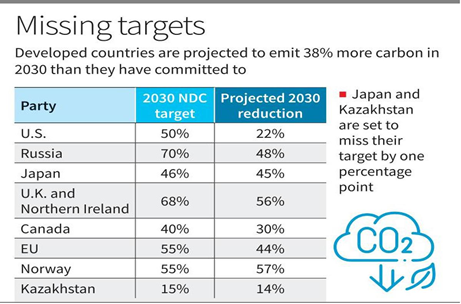

30th October 2023 (11 Topics)
Context:
According to a recent study by the Council for Energy Environment and Water (CEEW), U.S, Russia and EU are responsible for 83% of the projected Carbon overshoot. Developed countries were able to meet their 2020 targets largely due to COVID-19 lockdowns.
Developed countries and carbon emission:
- The analysis shows that developed countries — responsible for three-fourths of existing carbon emissions in the atmosphere — will end up emitting 38% more carbon in 2030 than they have committed to, going by current trajectories.
UN Framework Convention on Climate Change – COP 28:
- The UN Framework Convention on Climate Change is going to hold its 28th Conference of Parties (COP-28) at Dubai in November and December.
- Countries are expected to give an account of their Nationally Determined Contributions (NDCs), which are their commitments to the UN on emission cuts.

Findings of the Study:
- Countries falling short of their targets: The CEEW study noted that the NDCs of developed countries already fall short of the global average reduction of emissions to 43% below 2019 levels that is needed to keep temperatures from rising above 1.5°C. Instead, developed countries’ collective NDCs only amount to a 36% cut.
- While these countries ostensibly kept their promise and cut emissions by 20%, it was not the result of any “planned exercise”; in fact, a significant chunk of the cuts were the result of the COVID-19 pandemic that caused a global economic slowdown
|
What are the Commitments?
|
Postponing needed cuts:
- To keep temperatures below 1.5°C, developed countries need to cut emissions to 43% below their 2019 level.
- However, the CEEW study found that, based on their current emissions trajectories, their cuts would likely amount to only 11% by 2030.
- Except for two countries — Belarus and Norway — none of the developed countries seem to be on the path to meet their 2030 targets, though Japan and Kazakhstan are close, and are expected to miss their targets by only a single percentage point.
- Most developed countries appear to be planning to achieve their 2050 net zero targets by taking on deep emission cuts only after 2030; which, going by their own track record, seems over-ambitious.
- For instance, were all developed countries to reach net zero by 2050, they would require more than four times the average annual reductions they achieved between 1990 and 2020.
Shifting the burden
- The climate journey of developed countries — historical and proposed — does not show deep enough emission reductions to reflect climate leadership.
- This means that the burden to mitigate global warming shifts to developing countries, which is problematic in a context where financial support to developing countries to achieve this transition has not been forthcoming, as promised
- Instead of relying on future events, developed countries should define clear year-on-year reduction plans to meet their targets in this critical decade.
- Further, to build trust, developed countries need to be reliable and stay committed to the Paris Agreement.
Carbon Divide between Developed and Developing countries:
- One of the major sticking points in global climate negotiations is the extent and speed with which individual countries must transition away from the use of fossil fuels.
- Developing countries say that developed countries, who are responsible for most of the carbon burden, must pay developing countries for transitioning and wean themselves away faster.
- Developed countries argue that countries such as India and China, given their size, cannot entirely absolve themselves from steeper emission cuts.
- Developing countries have also not received much of the billions of dollars promised by developed countries to aid renewable-energy infrastructure.
Way Forward:
- When developed countries exceed their carbon emissions goals, the global climate crisis escalates. Their emissions contribute to rising global temperatures, intensified extreme weather events, and ecosystem disruptions.
- This undermines international efforts to combat climate change, as it sets a poor precedent for collective action.
- Developing countries, often hit hardest by these changes, face increased vulnerabilities, hampering global equity.
- To forge a path forward, coordinated global commitments, stricter emissions controls, and financial support to developing nations are imperative.
- Only through united efforts can we mitigate the crisis and secure a sustainable future for all.


